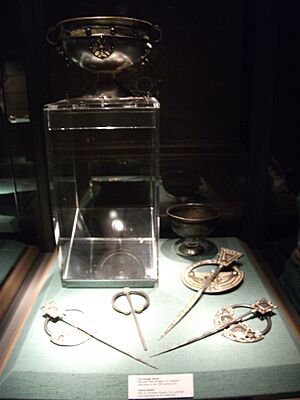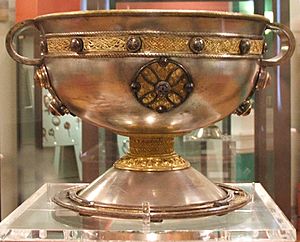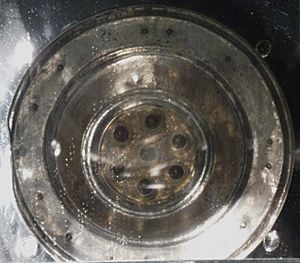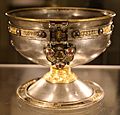Ardagh Hoard facts for kids
Quick facts for kids Ardagh Hoard |
|
|---|---|

The Ardagh Hoard on display in the National Museum of Ireland in Dublin, 2010
|
|
| Material | Copper-alloy |
| Created | 8th century |
| Discovered | 1868 Ardagh Fort, Ardagh, Ireland |
| Present location | National Museum of Ireland, Dublin |
The Ardagh Hoard is a collection of amazing metal objects from the 8th and 9th centuries. It's most famous for the beautiful Ardagh Chalice. Two young boys, Jim Quin and Paddy Flanagan, found it in 1868. Today, you can see these treasures at the National Museum of Ireland in Dublin.
The hoard includes the famous chalice, a simpler cup made of copper-alloy, and four brooches. Three of the brooches are fancy "pseudo-penannular" types, and one is a "thistle" type. The thistle brooch is the newest item, suggesting the hoard was buried around 900 AD.
The Ardagh Chalice is considered one of the best examples of Insular art (art from Ireland and Britain in the early Middle Ages). It's also a top example of Celtic art. Experts believe it was made in the 8th century AD. The fancy brooches found with the chalice were similar to those worn by important people back then. Even priests might have worn them to fasten their special clothes.
How the Hoard Was Found
The Ardagh Hoard was discovered in September 1868. Two boys, Jim Quin and Paddy Flanagan, were digging for potatoes. They were on the side of a rath, which is an old ring fort (a circular fort made of earth). This fort was called Reerasta, near the village of Ardagh, County Limerick, in Ireland.
Paddy Flanagan stayed in Ireland his whole life. Jim Quin later moved to Australia. He lived his final years in Melbourne and is buried there.
The chalice held the other items, and a flat stone covered them. It seems the treasures were buried quickly, maybe just for a short time. The owner probably planned to come back for them later. The age of the brooches suggests the hoard was buried during the Viking period. This was a time when Vikings often raided Ireland. Quin's mother sold the hoard to George Butler, who was a Catholic Bishop of Limerick.
About the Chalice
The Ardagh Chalice is a large silver cup with two handles. It's decorated with gold, bronze, brass, lead, and enamel. It's made from 354 separate pieces! This complex way of building things was common in early Christian Irish metalwork. The main part of the chalice is made from two silver halves joined together. A fancy bronze band hides the join. The top of the chalice is about 7.5 inches wide.
Around the bowl, you can see the names of the apostles carved into the metal. Below that, there's a band with gold wire designs of animals, birds, and geometric interlace patterns. Interlace is a type of decoration where lines or ribbons are woven together. The artists used many techniques, like hammering, engraving, and enamel work. Even the bottom of the chalice is beautifully decorated.
The Ardagh Chalice is similar to another important early Irish cup, the Derrynaflan Chalice. That one was found in County Tipperary, which is next to Limerick. Some people thought the Ardagh Chalice was made in a place called Clonmacnoise and then stolen by Vikings. However, there's no proof of this. It's just as likely, or even more likely, that it was made in the Munster region (where Limerick and Tipperary are). This is because the Derrynaflan Hoard was found there in 1980. The National Museum of Ireland website doesn't say it came from Clonmacnoise.
The chalice has been featured on an Irish postage stamp. Also, two important Gaelic Athletic Association (GAA) trophies, the O'Duffy Cup and the Sam Maguire Cup, are designed to look like the Ardagh Chalice.
Images for kids
See also
 In Spanish: Cáliz de Ardagh para niños
In Spanish: Cáliz de Ardagh para niños




